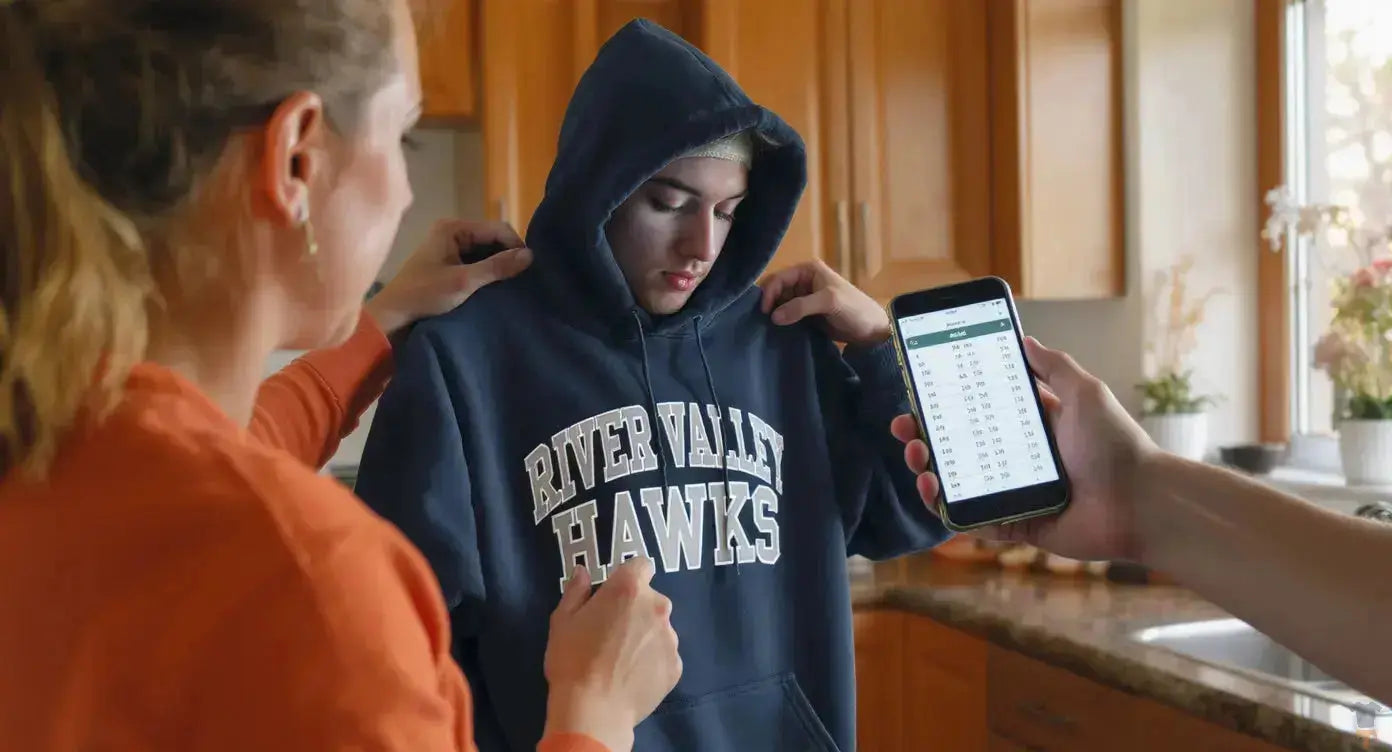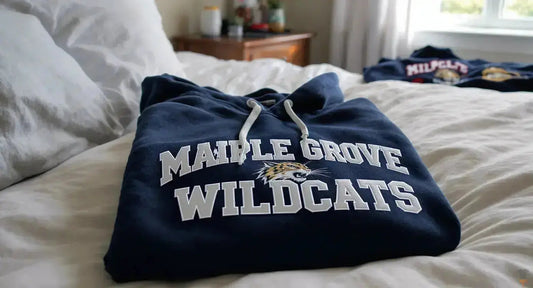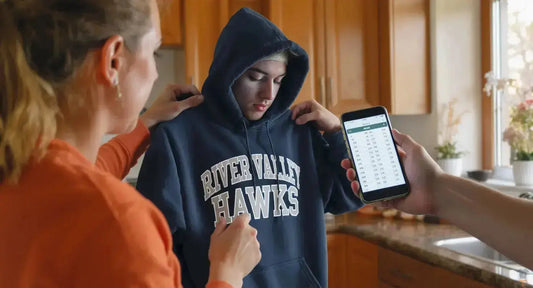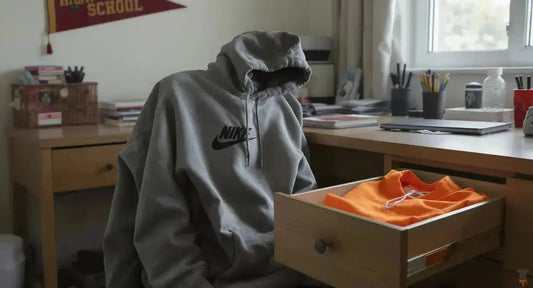
Spirit Wear Sizing Guide for Parents
Ordering spirit wear online means guessing sizes. Here's how to get it right the first time.
Why Spirit Wear Sizing Feels Like Guessing
You're browsing your school's online spirit wear store at 10pm on a Tuesday, trying to decide between a youth large and adult small for your 12-year-old. Will the youth large be too tight by December? Will the adult small swallow them whole? You toggle between product images, check the measurements one more time, and still aren't sure. This is the reality of buying spirit wear online - you're making decisions about sizing without the benefit of trying anything on first, and the wrong choice means your child either refuses to wear it or outgrows it before the season ends. The anxiety is real because spirit wear isn't like regular clothing. These items are custom-printed with your school's name and logo, which means most stores have strict no-returns policies except for quality defects. You can't just send it back if the sizing is wrong. Understanding how different brands fit and when to size up or down removes most of this guesswork.
Different Brands Fit Completely Differently
The biggest mistake parents make is assuming all spirit wear fits the same way. A youth large hoodie from Nike fits nothing like a youth large from Gildan, and Champion falls somewhere in the middle. These aren't small differences - they can mean a full size variation in how an item actually fits your child. Nike tends to run small across their entire product line, which means if your child typically wears a youth medium in most brands, they'll probably need a youth large in Nike spirit wear. This applies to hoodies, quarter-zips, and t-shirts. The athletic cut Nike uses is designed closer to the body, so there's less room for layering or growth. Champion fits true to size for most children and adults, making it the safest bet when you're unsure. If your child wears a youth large in their regular school clothes, a Champion youth large will likely work well. The fabric also tends to have a bit more give than Nike, particularly in their sweatshirts and hoodies. North Face runs slightly large, especially in their outerwear. A North Face quarter-zip or jacket in youth large might fit more like an adult small from other brands. This is actually useful for parents who want items to last longer, but it can look oversized if you're aiming for a fitted look. Budget brands like Gildan and Port & Company tend to run true to size but with a boxier, looser fit. These work well for layering or for children who prefer more relaxed clothing, but they don't have the same tailored look as premium brands.
When to Order Up and When to Stick True to Size
The order-up-one-size strategy works for some items but ruins others. The key is understanding which pieces your child will wear repeatedly versus which are for specific occasions. For everyday hoodies and quarter-zips that your child will wear throughout the school year, ordering one size up makes sense. A youth large ordered in August might fit perfectly now but feel snug by February, while a youth extra-large gives room for growth without looking ridiculous. Hoodies in particular benefit from this approach because a slightly oversized hoodie still looks normal and gives your child room to layer underneath during colder months. T-shirts should stick closer to true size because an oversized t-shirt looks sloppy rather than comfortable. If you're ordering t-shirts for spirit week or special events where your child will wear the item a few times rather than weekly, true to size ensures they'll actually wear it. The exception is if you know a growth spurt is coming - some parents of pre-teens and young teens deliberately order adult small t-shirts instead of youth large, knowing their child will grow into it. Quarter-zips and pullovers can go either way depending on the look you want. A fitted quarter-zip looks sharp for picture day or special events, while a roomier fit works better for athletic practices or casual weekend wear. Most parents find success ordering true to size for quarter-zips because they're meant to be layering pieces - too large and they bunch under jackets, too small and they're uncomfortable. Outerwear like North Face jackets should be ordered with growth in mind. These are investment pieces that cost more but last multiple seasons if sized correctly. Ordering one size up gives your child room to wear the jacket for two or possibly three school years.
The Youth to Adult Sizing Jump is Bigger Than You Think
The transition from youth extra-large to adult small is where many parents miscalculate. These aren't consecutive sizes - there's a significant jump in measurements that can make adult small feel huge on a child who's just outgrown youth extra-large. Youth sizing typically stops at extra-large, which is designed for children roughly 12-14 years old and about 140-150 pounds. Adult small is designed for adults roughly 5'6" to 5'8" and 140-160 pounds. The difference isn't just in chest measurements - adult small has longer sleeves, a longer body length, and assumes different body proportions than youth extra-large. For most middle schoolers, youth extra-large is the better choice even if it feels slightly snug, because adult small will have sleeves that hang past their hands and a body that reaches mid-thigh instead of waist. The exception is tall, slim children who have adult height but youth weight. These kids often fit adult small better than youth extra-large because the length works for their frame. If your child complains that youth extra-large sleeves or body length are too short, try adult small. Girls' sizing adds another layer of complexity. Some brands offer junior sizes that sit between youth and adult, with a slimmer cut than unisex youth but shorter length than women's sizes. Junior sizes work well for teenage girls who find youth sizing too boxy but women's sizing too long. Women's small is cut for adult female proportions with a defined waist and longer torso, which doesn't work for most middle school or early high school girls. When in doubt for teenage girls, youth extra-large or junior sizes are safer than jumping to women's.
Measure Once Order Confidently
Most spirit wear stores include size charts, but these are only helpful if you know your child's actual measurements. Taking five minutes to measure properly prevents ordering mistakes. Use a soft measuring tape and have your child stand normally - not stretched tall or slouched. For chest measurement, wrap the tape around the fullest part of the chest under the arms and across the shoulder blades. Keep the tape level and snug but not tight. Compare this measurement to the size chart's chest measurement, not their age or current clothing size. Chest measurement is the most reliable indicator of fit. For sleeve length on quarter-zips and hoodies, measure from the centre back of the neck, across the shoulder, and down the arm to where you want the sleeve to end. Most children prefer sleeves that reach their wrist bone or slightly past it. Size charts sometimes list sleeve length from the shoulder seam rather than the neck, so adjust your measurement accordingly. Body length matters for hoodies and longer shirts. Measure from the highest point of the shoulder straight down to where you want the item to end. For hoodies, most children prefer the hem to hit at the hip or slightly below. Keep these measurements in a note on your phone. Children's measurements don't change dramatically month to month, so you can reference them whenever spirit wear shopping throughout the year. When measurements fall between two sizes on the chart, consider the brand and item type. For fitted items or premium brands like Nike that run small, size up. For relaxed-fit items or brands that run large like North Face, stick with the smaller size. And remember that no minimums means you can order a single item to test sizing before buying multiples.
One Wrong Size Isn't the End of the World
Even with careful measuring and brand knowledge, sometimes you'll order the wrong size. The good news is that most children can make slightly-off sizing work, particularly with hoodies and casual wear. A hoodie that's a bit big becomes their favourite oversized comfort piece. A t-shirt that's slightly small works fine for layering under flannels or jerseys. The items that are truly unwearable - adult sizes on elementary children or youth sizing on high schoolers - are rarer than parents fear. Your school receives 15% from every purchase, so that too-small t-shirt still supported your school's programs. Order with confidence using these guidelines, and remember that items ship within 3-5 business days, so there's time to reorder if needed.
Frequently Asked Questions
What You Need To Know
Should I order one size up for growth?
What if measurements fall between two sizes?
Do youth and adult sizes overlap?
How do I know which brand my school offers?
Can I return spirit wear if the size is wrong?
Read More Blog Posts
-

Five Spirit Wear Items Parents Actually Need to...
Most spirit wear sits unworn in closets. These five pieces get used all year long.
Five Spirit Wear Items Parents Actually Need to...
Most spirit wear sits unworn in closets. These five pieces get used all year long.
-

Spirit Wear Sizing Guide for Parents
Ordering spirit wear online means guessing sizes. Here's how to get it right the first time.
Spirit Wear Sizing Guide for Parents
Ordering spirit wear online means guessing sizes. Here's how to get it right the first time.
-

Why Teens Wear Some Spirit Wear and Ignore the ...
Most parents have a drawer full of unworn spirit wear. Here's how to buy pieces your teen will actually wear.
Why Teens Wear Some Spirit Wear and Ignore the ...
Most parents have a drawer full of unworn spirit wear. Here's how to buy pieces your teen will actually wear.



















